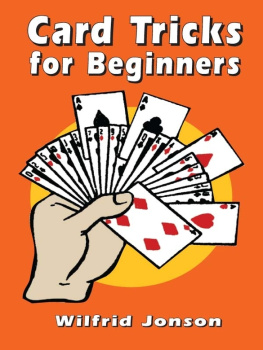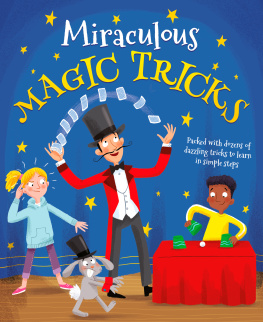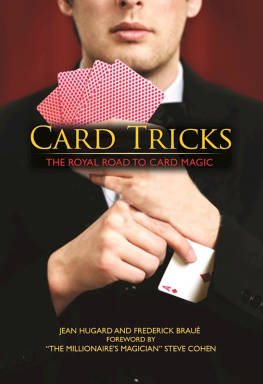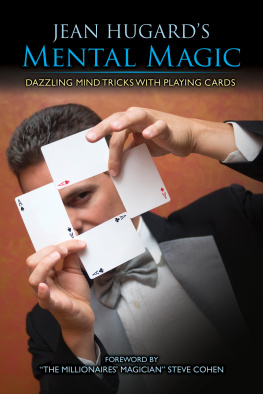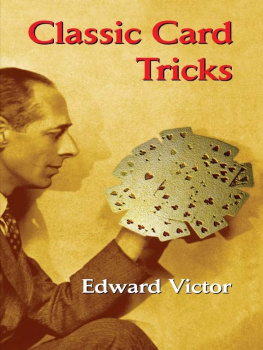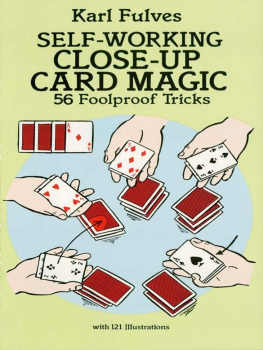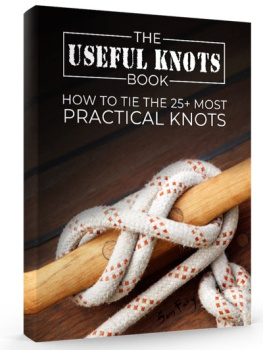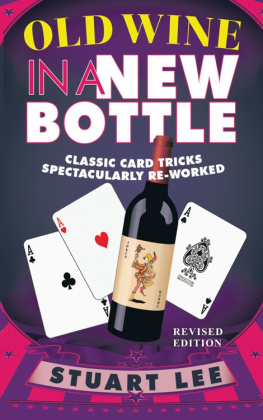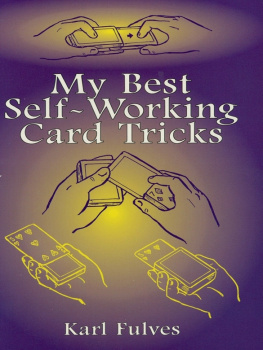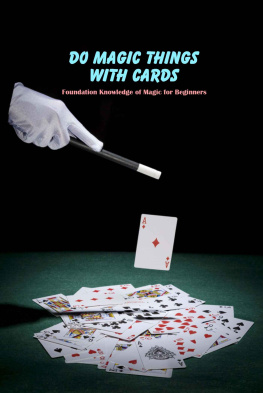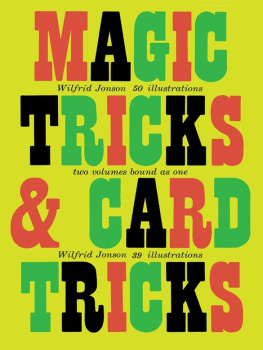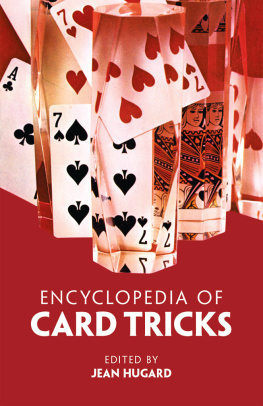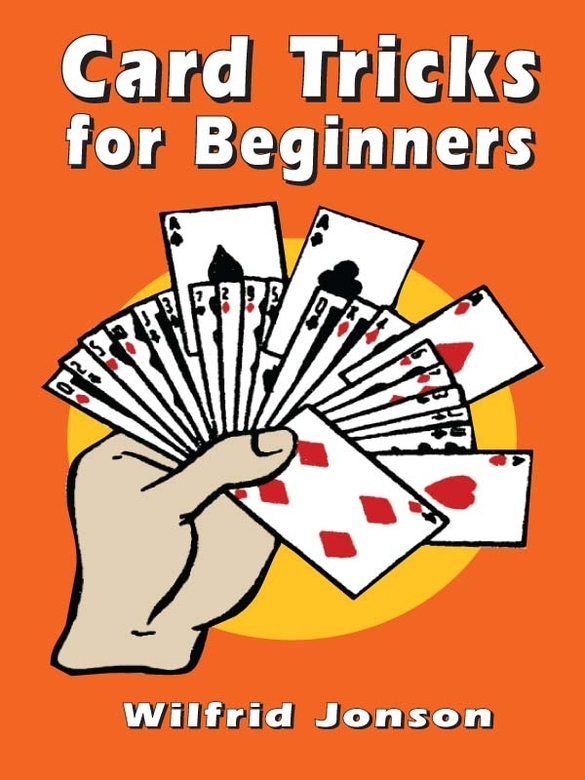Erdnase, S. W. The Expert at the Card Table. Chas. T. Powner Co., Chicago, 1944.
Hilliard, J. N. Card Magic. (forms part of separate book, Greater Magic .) C. W. Jones, Minneapolis, Minn., 1945.
Hugard, J., ed. Encyclopedia of Card Tricks. Max Holden, New York City, 1937.
Hugard, J. and Fred Braue. Expert Card Technique. G. Starke, New York City, 1950.
Hugard, J. and Fred Braue. The Royal Road to Card Magic. Harper and Bros., New York-London, 1948.
Young, M. N. Hobby Magic. Trilon Press, Div. of Magazine & Periodical Pntg. & Pub. Co., Inc., Brooklyn, N. Y., 1950.
THATS IT
With a card that you know upon the bottom of the pack, you put it down upon the table and ask a spectator to cut it into two parts. Invite him to take a card from either portion and to show it to the company, without letting you see what card it is. When the card has been shown to all, ask the chooser to replace it upon either portion and note carefully upon which heap he does replace it, but do not let your interest in this point be apparent to the spectators.
If he replaces the card upon the portion that was previously the uppermost part of the pack, tell him to drop the other portion on top of it. Let him then cut the pack and complete the cut in card playing fashion.
But should he replace the card upon the other packet, the original bottom part of the pack, ask him to cut that portion and complete the cut, thus burying the selected card in that packet, to put the two halves of the pack together and to cut once more.
Perhaps we had better clarify this business of cutting for the benefit of any readers unacquainted with card playing practice. In games of cards the person who shuffles the pack places it upon the table before a second player who cuts by lifting off a portion of the cards and putting them down on the table by the side of the remainder of the pack. The dealer then completes the cut by picking up the original lower portion and placing it upon the other. So, when these actions are combined by one person, to cut and complete the cut one lifts off a portion of the pack and puts it down on the table. One then picks up the remainder of the cards and puts them on top of the other portion. Cutting the pack is often regarded as the great safeguard of the honest player against the crooked gambler, and many card players display a faith in the virtues of cutting which is not borne out by the facts, as will presently be clear to you.
But to return to our trick. Whichever of the two procedures outlined above has been followed, the practical result is the same, the original bottom card of the pack has been placed immediately above the selected card.
You now take the pack and turning it face upwards, spread it from left to right in a long overlapping row, so that the indices of all the cards can easily be seen. With a little practice you will find that, with a good clean pack of cards, you can do this with one swift and skilful sweep of the hand. Now you hold your forefinger an inch or two above the cards and say to the chooser of the card: I will pass my finger slowly along the cards like this. When it passes above your card I want you to think to yourself Thats it. Do not say anything, do not move a muscle, but every time my finger passes over your card simply think to yourself, Thats it.
You pass your finger slowly along the row of cards from one end to the other and you look for the card you know, the original bottom one. The chosen card is the one below it, the one to its right in the row of cards. You do not pause when you reach it but carry on to the end of the row and say: I did not get it that time. Again please. You carry your finger back along the row and a little way past the selected card; then you pause and let your hand, with its pomting finger, swing in pendulum fashion, above the section of the row of cards in which the selected one lies. Then in a hesitant fashion you lower your finger and let it fall upon the chosen card.
In card conjuring one can often do more by intelligent planning and anticipation than by much sleight-of-hand and it would be a great pity if, at the conclusion of the preceding trick, one failed to take advantage of the fact that the cards are all spread out before you. So, before you gather them up you will remember the third and fourth cards from the bottom, that is from the right hand end of the overlapping row. Then you slip one finger beneath the top card, the card at the left hand end, and neatly gather up the overlapping row of the cards with one quick sweep of the hand. Much of the charm of good conjuring lies in the precision and dexterity with which the performer handles the cards and even such a simple action as gathering up the spread out pack can be done with elegance and distinction.
A MATHEMATICAL CERTAINTY
Knowing the names of the third and fourth cards from the bottom you put the pack down upon the table and ask one of the spectators to cut it into two heaps. When he has done so you ask him to touch one of the heaps. And here we come to an artifice often used in conjuring.... to apparently give a spectator a free choice when, in reality, whatever he may say the trick will take the same, premeditated, course. If the spectator touches the original bottom half of the pack you ask him to pick up that half, while you yourself pick up the other half. But if he touches the original top half you pick that up yourself, saying, Very good. Will you take the other half then. Notice that you do not ask him to choose one of the heaps but simply ask him to touch one of them.
You now ask the spectator to do everything that I do. Will you count your cards first. You count by dealing the cards one by one on to the table. The spectator does the same and as counting in this manner reverses the order of the cards, the two cards that you know were previously the third and fourth from the bottom will now be the third and fourth from the top of his heap of cards. Announce the number of cards in your heap and ask how many he has. Behave as if the matter was important. Actually it has nothing whatever to do with the trick but it is valuable misdirection. Whatever number he announces ask him to discard one card. He will naturally discard the top one.
Ask him next to continue doing exactly as you do. Take the top card of your heap and slip it into the centre. Wait while he does the same. Take a card from the bottom and put it into the centre. Take a second card from the top and place it in your right coat pocket. Take another from the bottom and put it in the centre of the cards you hold. Take one more card from the top and put it into your left coat pocket. Put your cards down on the table. If the assisting spectator follows all these actions, which have been deliberately designed to drag so many red herrings across the trail, the card in his right-hand coat pocket is the one that was originally the third from the bottom of the pack and the card in his left-hand coat pocket is that which was originally fourth from the bottom.
You bring the trick to a climax by saying, It is a mathematical certainty that this card in my left-hand pocket being the.... (you bring it out and name it as you show it) the card in your right-hand pocket is the.... (you name the first of the two cards you have remembered) and this one being the.... (you take the card from your right-hand pocket and name it also) the one in your other pocket is the... (You name the second card you have remembered.) Am I right, sir?

